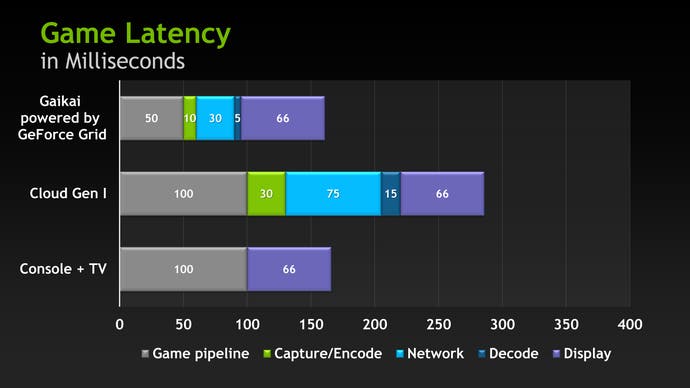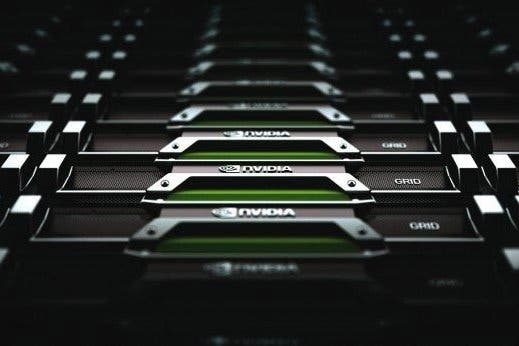Digital Foundry: Hands-on with GeForce Grid
Can Nvidia deliver a 'Netflix for games' platform that really works?
At a recent media briefing, Nvidia revealed that its GeForce Grid cloud gaming system is rolling out in the UK and Europe, with a range of AAA titles available to stream for free - as long as you own an Nvidia Shield device. At Digital Foundry, we've got a long history of healthy scepticism about gaming systems like this, or more specifically the technologically impossible claims often made for them. So is GeForce Grid the 'Netflix for games' Nvidia reckons it can be, or is it just cloud cuckoo land?
Well, first of all, kudos to Nvidia for laying on a stripped-back, transparent display of the technology in action, and for daring to showcase a cloud gaming platform in less than ideal conditions. The event was hosted at the Hilton in Reading, with a high-end router plumbed into the hotel's less than stellar broadband. A Shield Tablet ran the demo, plugged directly into a standard HDTV via HDMI. Diagnostics ran directly on the tablet used for the demo revealed just 8mbps of bandwidth available (GeForce Grid demands a max of 6.5mbps with Nvidia actually recommending a 10mbps connection to provide a comfortable overhead) and while the ping to the EU Grid server in Dublin was a creditable 26ms, any one who's ever used hotel internet services knows that the quality of service dips at a moment's notice.
That manifested in occasional stutter during the demo - the extent of which varied seemingly according to the whims of the lacklustre internet connection. However, at its best, the GeForce Grid demo came across as the best cloud gaming experience we've tested to date. Over 20 titles were available to access, and while we saw Batman: Arkham City's initial scenes play out nicely enough, the system was really put through its paces in Ultra Street Fighter 4. Here we can confirm that Grid is indeed supplying 60fps video, while latency seemed a generation beyond other services we've tried. Selecting Ken and tapping the light punch button made for a decent-enough latency test, producing fast responses - something we're looking forward to quantifying with some proper metrics once the Dublin servers go live to the public in December.
Ultra Street Fighter 4 is a fast action game, with plenty of movement and vibrant colour schemes - factors that don't play nicely with the h.264 compression system utilised by cloud gaming systems. However, Grid acquitted itself fairly well, with just a touch of blur manifesting during the pyrotechnic super-move sequences. Bearing in mind that we were standing less than a metre away from a large flat-panel HDTV, that's a pretty impressive showing. Of course, this is just impressions based on one game and the video encoding challenge varies according to the complexity of the image on a per-game, per-frame basis. Other titles may vary, something we'll look at more closely when the service goes live, but first impressions seem promising. [UPDATE 13/11/14 2:06pm: Grid's video stream runs at 720p60 and according to the game's setting menu, USF4 was rendering at 720p, with 4x MSAA.]

Consistent image quality and low latency are the two biggest factors in achieving a good cloud gaming experience, so what sets Nvidia's tech apart from gaming over IP systems we've seen before? Well, h.264 hardware encoding technology has improved considerably in the years since the launch of the 'gen one' OnLive, while GeForce Grid benefits from having that encoder embedded into the server GPU itself, cutting down latency significantly. The slide above, which is a couple of years old now, breaks down the component elements in cloud gaming latency. Back then, we looked upon Nvidia's Grid measurements as a best-case scenario, but based on the demo we played earlier this week, the numbers certainly seem plausible applied to the actual service for the majority of the duration.
The fact that it's taken over two years for Nvidia to bring Grid to market - even in preview form - comes down to two factors. First of all, the collapse of OnLive drained confidence (and investor cash) in the cloud gaming dream, while Sony's Gaikai buyout effectively deprived Nvidia of the partner and the brand it needed to gain traction. However, the delay may actually have worked out for the best overall - certainly in the UK, the roll-out of mega-bandwidth fibre-optic connections can only help in making cloud gaming a viable gameplay experience by providing a more robust background infrastructure to support it.
Nvidia is also taking things slowly. There's absolutely no reason why GeForce Grid can't run right now on any computer, tablet or even smartphone. The Shield exclusivity period (which runs until 30th June, 2015) is surely all about putting the infrastructure and the servers through their paces on a limited audience, before a larger scale roll-out. Details are a touch vague on Nvidia's actual end-game here, though the 'Netflix for Games' messaging suggests that the business model will be based on a monthly subscription that offers 'all you can eat' access to a range of older library titles.
In the short-term, the Grid preview is certainly a welcome boost for the Shield Tablet. In our review of the device, we loved the hardware but wanted more in the way of software. The GeForce Grid preview roll-out is kicking off in combination with the release of Shield exclusives including Half-Life 2: Episode 1, a Shield-enhanced version of Oddworld: Stranger's Wrath and a conversion of Born Ready Games' Strike Suit Zero. Nvidia also revealed that buyers of the 32GB LTE version of its tablet get a 'Green Box' promotional bonus, consisting of free copies of Portal, Half-Life 2 and Half-Life 2: Episode 1 bundled with the slate.

